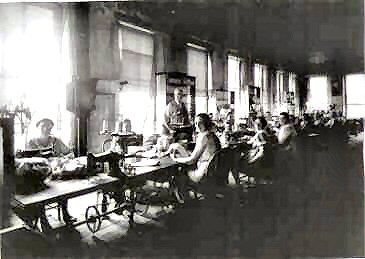
A WOOLEN FACTORY.
NOT long since, while passing down Front Street of one of our beautiful Western towns, the noise from a large four-story brick building attracted my attention. I found it to be a woolen factory, where all kinds of woolen goods are manufactured. One hundred men, women, and little boys are daily employed. The building is situated on the Des Moines River, across which, just above the factory, is a large dam affording the water power. Just below the factory a bridge 900 feet long gives the country people on the other side of the river town privileges.
But about the building. As I said before, it is four stories besides a basement; and in one room of this is the monstrous engine, which keeps all the machinery in the building in motion. Into one of these basement rooms the wool is brought just as it comes from the sheep's back; and here two men were employed in washing, drying, and dyeing it.
In another room a man was sprinkling the wool with oil, in preparation for carding. Great baskets full of this prepared wool were carried above, where little boys from ten to fourteen were picking, sorting, and weighing the wool, then placing it upon large rollers which, in turning, passed long cards. These soon passed it off in long rolls, which, after being wound upon great spools, were carried to another room, where they were put upon large spinning machines. Upon each machine were from two hundred to two hundred and twenty small spools. Each machine was tended by a young man, and there were seven machines; so that while the old-fashioned spinning wheel was turning off one spindleful of yarn, these seven machines would fill over fourteen hundred. These spools, after being filled, were piled in a large basket, and part of them carried to the third, and part to the first, floor.
In the third story the yarn was taken from the spools and reeled upon a mammoth reel, where about twelve skeins were reeled at once. These skeins were then handed to another woman, who twisted them, packed them in bunches, and tied them ready for sale.
The yarn taken to the first floor was for the warp and filling of woolen goods. Here were three long rows of looms just like the old-fashioned looms, only all of, iron, and the shuttle was thrown back and forth by the machine. A woman stood before each loom, to see that all was right, and change the yarn for the different colors. One woman had made a mistake, which was causing her much trouble, and wasting much material.
As I watched her busy fingers rectifying the mistake, I thought, How like life! Often on account of carelessness we make mistakes that it takes many days of sorrow to correct. In another room there were three machines for stretching, drying, and dressing the cloth, after it was taken from the loom. In this room were two desks at which young women were picking knots from the cloth before it was dressed. Here also the cloth was folded in great bolts, tied with pink tape, and piled up ready for transportation. Just across the street is a large building where the goods are stored.
This is only a poor description of all we saw as we passed through the buildings, but it perhaps will give some idea of how much work it takes to make the nice woolen cloth that we wear so much.
MRS. I. J. HANKINS.
